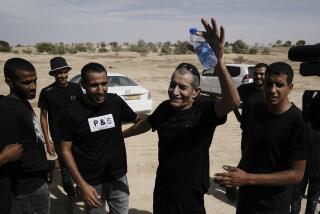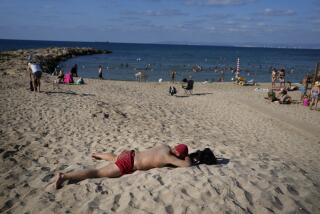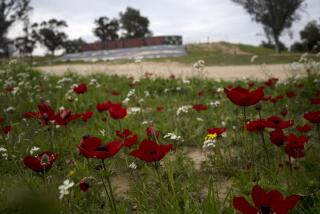Negev Desert Remains the Land of Ben-Gurion
- Share via
SDE-BOKER, Israel — As the sun tints the desert canyon mauve, pink, amber and gold and a breeze ruffles the pepper tree shading two graves, a girl picks up a stone. Gently, reverently, she lays it on one of the graves. She picks up another and lays it on the other grave.
The “grand old man”--David Ben-Gurion--is buried here in his beloved Negev Desert overlooking the deep and abiding Zin Canyon. Paula, his American wife from New York City, is at his side.
The canyon, a great cavern of jagged, scabrous boulders and craters, stretches miles north and south. Across the distant rim, burning sapphire skies sear barren, formidable hills, defying habitation.
This is Ben-Gurion’s desert.
The grave of Israel’s founding father is near Sde-Boker Kibbutz, an oasis of peach, fig and olive trees about 45 minutes south of Beer Sheva, capital of the Negev.
Beauty of Desert Flora
A path bordered by tiered limestone winds to the site. It is adorned by plants from the world’s major deserts, a testimony to the beauty and spirit of desert flora.
Since Ben-Gurion’s death, thousands from many nations have journeyed to Sde-Boker in tribute to the man who dared the desert to bloom.
Ben-Gurion’s grave, with its spectacular canyon view, is a top tourist attraction. And tourism to the Negev’s canyons, craters and steep passes, archeological sites and new agricultural settlements has increased 200-fold.
Beer Sheva, once a dusty, frontier town built to house immigrants while Bedouin camels plodded unmarked streets, is a metropolis of 120,000. The city boasts a chamber orchestra, a repertory theater, a municipal museum and the Ben-Gurion University of the Negev, where desert life and development is under constant study.
On the way to Sde-Boker from Beer Sheva the landscape changes from city to desert, stony dry hills and flats punctuated by struggling plants only goats could digest.
Travelers pass Bedouin tents with TV aerials and children scampering after sheep. Suddenly a grove of eucalyptus trees or field of green crops brightens the stark landscape. With irrigation, the Negev bears fertility.
Sde-Boker Kibbutz was founded to raise cattle and breed horses and in 1953 was only a few wooden buildings and one spindly tree surrounded by barbed wire.
When Ben-Gurion became a kibbutznik he labored in the fields. Later he became a shepherd; his wife Paula worked in the kitchen and nursery.
At Sde-Boker, Ben-Gurion’s former “hut” is a five-room aquamarine cottage with a red corrugated roof. Furnishings are simple. In the living room are a brown couch and four green chairs, along with a TV set and map of Israel.
In the study his desk is glass-topped, his wooden chair uncushioned. In the bedroom a photo of Mahatma Gandhi hangs over his bed. He cut it from a magazine and framed it himself. Worn leather slippers lie on a mat; piles of assorted books cover a night table.
Remarkable Scholar
Not only did Ben-Gurion become a renowned leader but a remarkable scholar. In his permanent home in Tel Aviv, now a museum, the second floor belonged to him--a tiny bedroom and four rooms containing his 20,000-volume library.
There you’ll find a staggering subject range--the voluminous Sacred Books of the East, philosophy tomes, hundreds of classics, books on military history, Europe, America and Islam, the history of the Zionist movement and Bibles in many languages.
-- -- --
Ben-Gurion’s Tel Aviv home on Ben-Gurion Boulevard (a few minutes from the Mediterranean) is open daily from 8 a.m. to 2 p.m., Friday to 1 p.m., and Monday and Thursday 5 to 7 p.m. Admission free.
Entrance to Ben-Gurion’s hut at Sde-Boker also is free. The kibbutz has a snack bar and serves lunch.
To tour the nearby archives of the David Ben-Gurion Research Center or the Blaustein International Center for Desert Studies, arrangements must be made through the public relations department at Ben-Gurion University of the Negev, Beer Sheva.
If you’re in Beer Sheva on a Thursday, don’t miss the bustling Bedouin market held weekly on Rehov Hevron opposite the wholesalers’ market, from 6 a.m. to 2 p.m.
Bedouins converge to hawk beaten copperware, jewelry, embroidered camel bags, hand-woven rugs, ceramics, exotic spices, fruits, vegetables, grains, kitchenware, clothing, chickens and turkeys.
Photo buffs will have a heyday, but many Bedouins demand at least a shekel (about 75 cents) per shot to pose.
At the market you’re expected to bargain. If Arabic or Hebrew isn’t your language, English works fine. Be flexible.
Shops in Israel generally feature a wide variety of gifts ranging from jewelry and diamonds to Oriental carpets, clothing, leather goods, ceramics, furs and antiques.
Oriental markets and bazaars are especially good in the old cities of Jaffa and Jerusalem. Most stores are open daily from 8 a.m. to 1 p.m. and from 4 to 7 p.m.
Taxi and bus service are excellent, as is sherut service. The sherut taxi seats six or seven passengers and operates on an urban and interurban basis following set routes. Though slightly more expensive than buses, sheruts are quicker and have more room for baggage.
Israel’s airline, El Al, offers a variety of travel packages. Call (800) 352-5786.
For information and accommodations in Israel, contact the Israel Government Tourist Office, 6380 Wilshire Blvd., Suite 1700, Los Angeles 90048, (213) 658-7462.
More to Read
Sign up for Essential California
The most important California stories and recommendations in your inbox every morning.
You may occasionally receive promotional content from the Los Angeles Times.









